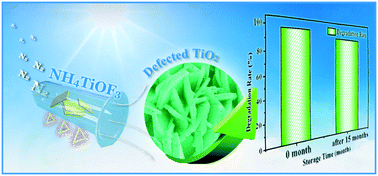An in situ solid-state heredity-restriction strategy to introduce oxygen defects into TiO2 with enhanced photocatalytic performance†
Abstract
Oxygen vacancies are widely investigated because they are a vital factor in semiconductor photocatalysis. The formation of oxygen vacancies mainly depends on a reduction method with a complicated process which causes environmental pollution. In this research, a precursor with deficient oxygen atoms was selected and the amount of reacted oxygen used to form the defected target product was limited, which is an novel and environmentally friendly solid-state strategy to create oxygen vacancies in situ on the surface or into the bulk lattice of titanium dioxide (TiO2) without using any reducing gases and reductive reagents. In particular, the precursor of ammonium oxofluorotitanate (NH4TiOF3) containing only one oxygen atom was designed and synthesized, and then, the amount of oxygen atoms was controlled to react with the titanium atoms in the as-created precursor. Finally, both the internal and exterior oxygen vacancies were simultaneously introduced into TiO2. The obtained photocatalyst, BNC, has a better photocatalytic performance for degradation than the photocatalyst BN5-NH obtained using traditional means of reduction. The photocatalytic degradation rate of BNC for model organic contaminants reached 95% after 12 min illumination. The photocatalytic performance was not obviously weakened after 15 months of use. This work provides a new and environmentally friendly method to create the surface or bulk oxygen vacancies for semiconductor materials, and may prepare the way for the design and synthesis of new and diverse defective materials for various applications.



 Please wait while we load your content...
Please wait while we load your content...